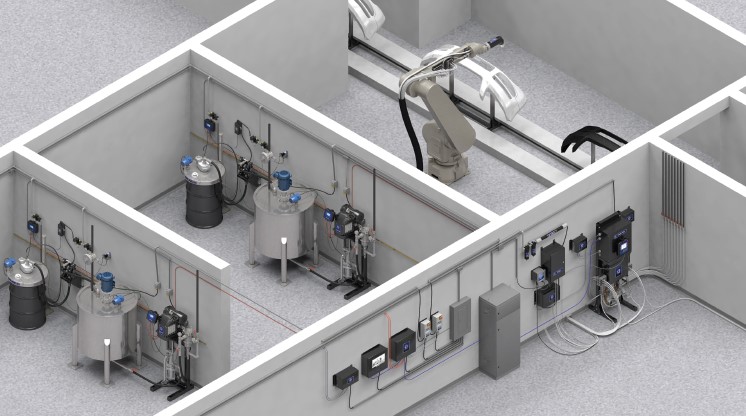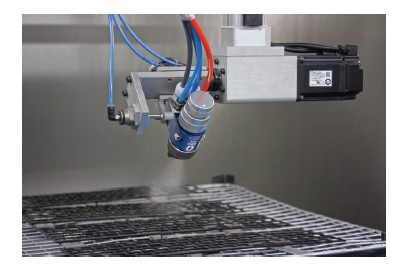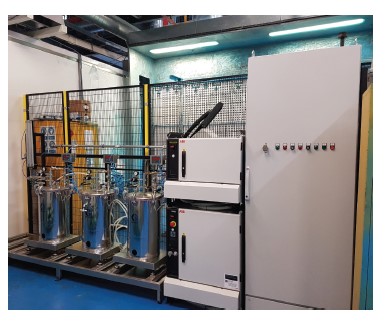Once considered a luxury, paint robots have now significantly dropped in price and are quickly becoming the norm in industrial finishing. These systems ensure consistent finish on every part, every time.
Better consistency also means less wasted material, and automated systems have been shown to reduce material consumption by up to 30 percent.
Automated Coating of Adhesives
An example of a company moving over to automation is Peak Contracts Ltd., based in Derby, UK. This company offers the general industry electrical and mechanical engineering solutions, ranging from modifications of existing plants and processes to the complete design and installation of a new plant.
Capabilities and services include paint finishing systems, air handling systems and electrical control systems, as well as project and site management, service and maintenance. Companies that they have completed projects with include major automotive manufacturers.
For one of their customers, Peak Contracts was looking into supplying a dual robotic spray system for two-component water-based sprayable adhesives for automotive interior trim components.
The challenge was to set up and pre-program the two robots with three different premixed two-component water-based adhesives and spray onto many various products in the same production line.
Peak Contracts designed the robotic system with their own PLC/graphic user interface and integrated the Graco fluid supply and spray equipment.
They used three AirPro automatic spray guns, three pressure feed containers and three air operated fluid regulators in the system, which they bought from local Graco distributor Fluid Technologies Ltd. The system was completely assembled and tested offline and then installed into the production line by the Peak Contracts team.
The dual robotic spray system is simple to operate using the Graco stainless steel pressure tanks, which stand on weight sensors to give level indication on the graphic user interface. Air operated fluid regulators allow to adjust the flow rates to the spray gun during the spraying program.
Moreover, they are fully opened during flushing. The AirPro spray guns provide very good atomization and are easy to clean after use. The quick detachable gun mount allows easy maintenance of the spray guns when in production.
After installation of the new robotic application system, the production throughput increased and the usage of adhesive reduced due to the automation of the manual process.
Automation of Soft-Touch Painting
Automation is also ideal for soft-touch painting, which is proving to be a rising trend, thanks to the ability to create a high-end appearance with lower cost materials.
A recent study found that the global soft-touch polyurethane coatings market is expected to expand at a compound annual growth rate of 7.2 percent from 2015-2025. Driving this boom is the ability of soft-touch materials to transform the sometimes uninviting feel of plastic into a comfortable rubber-, leather- or velvet-like sensation.
It turns a hard, cold plastic part into a warm, inviting object that says, “grab me.” On top of that, it exhibits high scratch and abrasion resistance, and protects the plastic from chemicals that may cause deterioration or ugly yellowing due to exposure to a harsh environment.
With its tough exterior and positive haptic effects, it still maintains a trendy low gloss, low reflectivity look. This allows manufacturers to take a relatively inexpensive material, such as plastic, and apply a coating to give it the appearance of a high-end luxury item.
The ability to create a high-end appearance with lower cost materials is driving many industries to adopt soft-touch coatings.
The automotive industry holds the lion’s share of the market, using soft-touch primarily to coat interior parts: steering wheels, front panels, door handles and trims, push buttons, air bag compartments and armrests. Similar applications are found in the aerospace industry on interior paneling of cockpits.
Soft-touch coatings are also commonly found on consumer goods found in the kitchen, such as coffee machines, ovens, refrigerators and even the handles on pots and pans.
In addition, the appearance, feel and protective qualities of soft-touch have become the norm for laptops, tablets, remote controls and mobile phone casings. Here they provide a nicer feel that also protects the product from common drops and prevents it from sliding off the table.
The scope of soft-touch has even spread beyond durable goods into the consumer packaging industry, where it is applied to everything from cosmetic bottles to food canisters.
This coating provides a high quality and even luxurious appearance to potential consumers. For this reason, many industries are turning to soft-touch to differentiate their products from those of competitors.
Applying Soft-Touch
The application process is essentially the same, but due to the minor differences in the makeup of the material, considering a few points could increase quality and greatly improve overall production, resulting in fewer headaches for those applying the coating and higher satisfaction from end users.
Most of the application equipment required for soft-touch materials is similar to that used for other finishing paints and coatings. Spray guns, pumps and agitators should all easily translate into soft-touch applications.
But, due to the heavy nature of this material, it tends to sag if it isn’t sprayed with the right parameters for the desired finish.
Before starting production with this new material, run a few tests to make sure the process parameters are right. Controlling parameters such as flow rate, spray gun air and pressure during the production process also will ensure desired consistency is met and maintained.
Keep in mind, it will be harder to get a consistent spray pattern near the end of the pot life cycle. The need for correct ratio mixing and impact of the pot life can bring into question the mixing strategy. Once mixed, the soft-touch resin and the catalyst have a specific window before the material can no longer be sprayed.
So, the biggest question to answer when looking to implement soft touch is, “What is the most efficient and effective way to mix?”
Electronic Mixing and Metering
One option is to hand mix the resin and the catalyst. It may be cheaper because it requires minimal technology, but it has many limitations. Most notably these are excessive waste, ratio accuracy problems, inconsistency between batches and consequent quality defects.
Electronic proportioners provide an automatic way to mix two-component materials on demand. The equipment utilizes meters, dosing valves and electronic closed-loop controls to mix materials to the proper ratio as the product is sprayed.
Only what is needed at that moment is mixed, which dramatically cuts down on the wasted material experienced with batch mixing. In addition, colors can be easily changed on the fly, flow rates can be controlled and access to alarms is available for quality control in case issues arise.
Electronic 2K systems have a track record for paying for themselves over time due to savings in waste and time.

Marc Gijbels
Product Marketing Manager IPD
Graco





